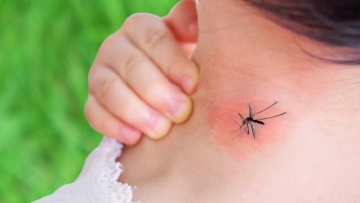Mosquito [Culicidae]
Controlling adult mosquitoes and eliminating their breeding sites can prevent the spread of diseases carried by mosquitoes. It will also alleviate the discomfort associated with mosquito bites in homes and hospitality establishments.


Damages caused / challenges
Health hazard
With the recent arrival of Asian tiger mosquitoes in Europe , increasing numbers of chikungunya fever, dengue, malaria and West Nile fever have been recorded. The presence of these mosquitoes is of rising concern to public health authorities, as some diseases are emerging in Europe or reappearing after a long absence.

Unpleasant bites and a bothersome buzz
Not all mosquitoes pose a health hazard but their bites cause itchiness, redness and swelling. Added to the discomfort associated with bites is the high-pitched, whining buzz produced by the flapping motion of the mosquito’s wings.
Unwelcome evening guests
Mosquitoes are active after dark and make unwelcome guests in bars and restaurants. They also infest homes, hotel bedrooms and farms. In other words, they will settle wherever suitable breeding sites can be found nearby.
Profile
| Scientific name | Culicidae |
| How to recognise it | A slender winged insect with thin legs Proboscis (elongated mouthpart) a distinctive feature in females, used to suck their host’s blood |
| Environment | Indoors and out Thrives in temperate climates and overwinters in sheltered sites Breeds in standing water |
| Behaviour | Most species Crepuscular/nocturnal, the Asian tiger mosquito (A edes albopictus or Stegomyia albopicta) is diurnal |
| Diversity | 3,000 species worldwide Common house mosquito (Culex pipiens) and banded mosquito (Culiseta annulata) previously the most common in Europe Now joined by Asian tiger mosquitoes (Aedes albopictus or Stegomyia albopicta) |
| Reproduction and life cycle | Female lays 100-300 eggs that form a raft floating on water Egg to adult mosquito cycle takes up to two weeks |
| Diet | High-sugar content sources of food for both males and females Vertebrate blood, including human blood, only for females |
How to control
Successful mosquito control is best achieved by recognition and treatment of breeding sites. A regular program of inspections should be organised so that insect activity is stopped at its very source.
Breeding sites
Mosquitoes breed in standing water, especially where organic debris is plentiful. Examples of prime breeding sites include ponds, lakes and ditches.
Mosquitoes can breed in very little water: clogged gutters, water butts, old tires, buckets etc. can also be sources of a mosquito infestation. These potential breeding sites should be cleared out and emptied of water. This preliminary operation is essential to the overall control programme.
Treatment programme
When dealing with active pest conditions, choosing the right products and application techniques can make all the difference. BASF offers fast-acting and long-lasting solutions for controlling mosquitoes.

